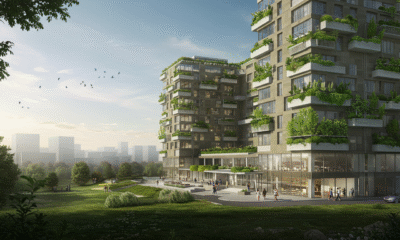

Features
Green Design Trends For Holistic Hospitals
Green design trends for holistic hospitals improve wellness while preserving the environment. Here’s an overview of what’s trending in hospital design.
Green design has taken numerous industries by storm, including some sectors you wouldn’t immediately expect. Sustainable layouts aren’t only for corporate offices and minimalist homes. Hospitals have also embraced environmentalism by creating holistic refuges for patients and workers.
Patients need their surroundings to be healthy and peaceful to facilitate recovery, and green design effectively accomplishes this.
Here are six popular green design trends for holistic hospitals.
1. Natural Lighting
Natural lighting illuminates a space without the costly electricity bills, but it also has therapeutic benefits. Numerous studies have shown that patients respond well to sunlight — their moods and sleeping patterns improve. Some even heal faster.
Scientists recently investigated how exposure to natural light can affect the duration of one’s hospital stay. They found that patients who stayed in beds near windows had shorter visits than those who remained by the door.
Staff can supplement sunlight with LED bulbs and sensors that turn lights off or on. Natural illumination layouts usually feature skylights and large windows, but it’s common to use energy-efficient bulbs in areas where the sun doesn’t reach.
2. Biophilic Design
Biophilic designs merge the human world with nature to create an environment of harmonious exchange. While there’s no strict definition, architects use biophilic design to include greenery, improve air quality and mimic natural structures.
You’ll encounter a lot of natural elements within a biophilic design, such as plants and wood or bamboo furniture. Sustainably sourced wood is a staple of many biophilic hospitals because of its aesthetic value and green properties.
This style is about more than adding plants to a room. It focuses on improving health through nature-based means, which could mean buying wood furniture with linseed oil finishes or installing circadian lighting fixtures in patients’ rooms.
3. Green Roofs
Clinics such as the Advocate Illinois Masonic Medical Center and Sharp Memorial Hospital feature green roofing within their sustainable strategies. Green roofs come in numerous styles, with some being partial additions while others cover the entirety of the roof.
They act as heat insulators and absorbers for stormwater, which reduces electricity usage and slows the spread of polluted runoff. Plus, green roofs help regulate building temperatures and reduce overall energy costs.
These roofs also serve as community centers for healing patients, allowing them to mingle with others and relax. When they’re able to relieve stress, they feel better faster — physically, mentally and emotionally.
4. Renewable Energy
Clean energy helps property owners reduce their carbon emissions and come one step closer to independent power usage. You may wonder how renewables can work within hospitals since electricity isn’t always available like it is with fuel-based sources.
That’s where energy storage comes in — such as backup generators and batteries. Once the wind stops blowing or the sun sets, operations can continue running due to stored power.
Some places have already taken advantage of clean electricity, such as CentraState Medical Center Solar panels account for 30% of CentraState’s electrical utilities, and they generate extra power during the day to cover nightly energy demands.
Other systems are moving toward net-zero energy consumption. The Gundersen Health System in Wisconsin uses a wood-powered boiler instead of natural gas. Since wood can be recycled and locally sourced, it’s a positive step away from reliance on nonrenewable energy sources.
5. Passive Ventilation
Sustainable ventilation systems are a must-have in hospitals, where chemicals and allergens can harm a patient’s health. Medical and janitorial staff keep their clinics as clean as possible for a reason. Fresh, unpolluted air is an essential part of recovery, and it also maintains the health of people who aren’t sick.
Many landowners use passive ventilation to cool and warm their interiors without coal-based power. This method involves opening windows for airflow, building with heat-absorbant materials and structuring walls for maximum sun exposure.
Opening windows isn’t always possible in a clinic, which is why comprehensive HVAC systems are necessary. Businesses can use energy-efficient HVACs alongside passive solutions to provide ventilation on every building level.
6. Low-Flow Plumbing and Irrigation
Low-flow toilets use 1.6 gallons per flush (GPF) in comparison to conventional models, which use 3.5 GPF. Similarly, water-conserving showerheads only output 2.5 gallons per minute (GPM), although some can go lower to 2 GPM.
Buildings with these plumbing systems lower their operating costs and employ fewer gallons of water with daily tasks. Low-flow systems avoid depleting groundwater sources, leaving more water for local communities.
Hospitals with green roofs often use irrigation to water the vegetation. This strategy conserves water by feeding H2O directly to the plants rather than spreading it across an entire area. Areas with low water availability can benefit from using irrigation to keep their vegetation healthy.
Green Design in the Healthcare Industry
Modern medical centers need redesigning to meet current health and ecological standards. That’s why there are a number of important green design trends for holistic hospitals.
Centering hospital structures on holistic recovery and environmental impact can save more lives while protecting Earth’s resources.





























